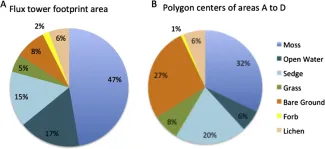Coastal tundra ecosystems are relatively flat, and yet display large spatial variability in ecosystem traits. The microtopographical differences in polygonal geomorphology produce heterogeneity in permafrost depth, soil temperature, soil moisture, soil geochemistry, and plant distribution. Few measurements have been made, however, of how water fluxes vary across polygonal tundra plant types, limiting our ability to understand and model these ecosystems. In this study, we investigated how plant distribution and geomorphological location affect actual evapotranspiration (ET). These effects are especially critical in light of the rapid change that polygonal tundra systems are experiencing with Arctic warming. At a field site near Barrow, Alaska, USA, we investigated the relationships between ET and plant cover in 2014 and 2015. ET was measured at a range of spatial and temporal scales using: (1) An eddy covariance flux tower for continuous landscape-scale monitoring; (2) An automated clear surface chamber over dry vegetation in a fixed location for continuous plot-scale monitoring; and (3) Manual measurements with a clear portable chamber in approximately 60 locations across the landscape. We found that variation in environmental conditions and plant community composition, driven by microtopographical features, has significant influence on ET. Among plant types, ET from moss-covered and inundated areas was more than twice that from other plant types. ET from troughs and low polygonal centers was significantly higher than from high polygonal centers. ET varied seasonally, with peak fluxes of 0.14 mm h-1 in July. Despite 24 hours of daylight in summer, diurnal fluctuations in incoming solar radiation and plant processes produced a diurnal cycle in ET. Combining the patterns, we observed with projections for the impact of permafrost degradation on polygonal structure suggests that microtopographic changes associated with permafrost thaw have the potential to alter tundra ecosystem ET. Reference: Raz-Yaseef N, J Young-Robertson, T Rahn, V Sloan, B Newman, C Wilson, SD Wullschleger, and MS Torn. 2017. Evapotranspiration across plant types and geomorphological units in polygonal arctic tundra. Journal of Hydrology 553: 816-825. https://doi.org/10.1016/j.jhydrol.2017.08.036
For more information, please contact:
Naama Raz-Yaseef
nryaseef@lbl.govMargaret Torn
mstorn@lbl.gov

